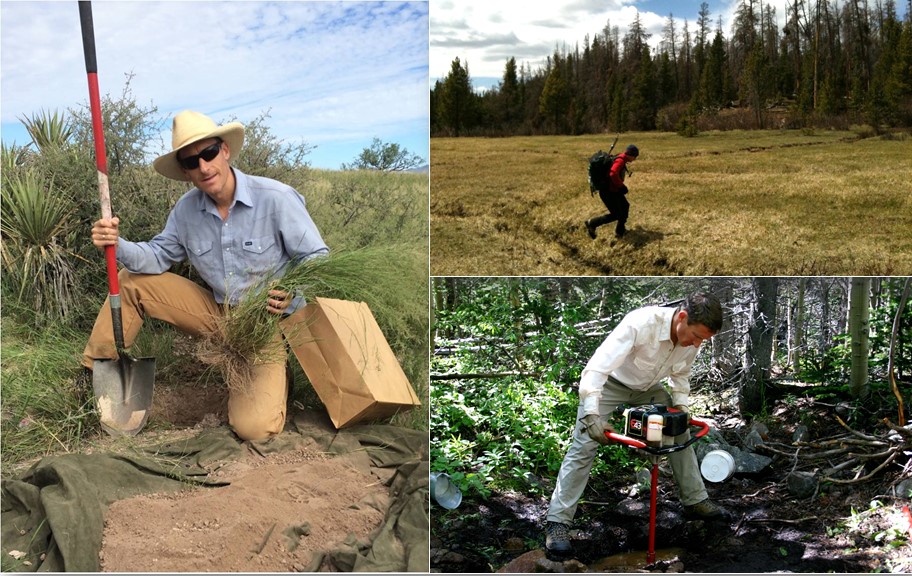This is the next in a line of periodic interviews with Fluxnet scientists. This installment is with Joel Biederman, who is a postdoc in Russ Scott‘s lab with USDA, near Tuscon, Arizona. More information on Joel is available through his ResearchGate Link (http://www.researchgate.net/profile/Joel_Biederman)

How did you come across the flux measurement community and what motivated you to use these data for your thesis and postdoctoral work?
For my dissertation in hydrology, I was testing the hypothesis that streamflow would increase following forest die-off in the Rocky Mountains. My initial interest in flux towers was simply using the ET as a check on annual water balance. Surprisingly, forest die-off didn’t increase streamflow, and a deeper look at the ET flux data confirmed that whenever there was water at the surface (soil moisture or snowpack), dead forest stands evaporated water at equal or greater rates to healthy forests, due to increased penetration of wind and radiation. This really got me excited about the power of flux data, and I found a postdoc in this field.
As you work more with flux data, what skills do you feel you need to acquire in the near future to make synthesis studies more effective?
We tend to think first of the technical skills, such as writing scripts to download and process data, but I have goals for skill development in two other areas. First, I want to continue building relationships with site teams, which are essential for guiding the development of synthesis research questions and drawing informed conclusions. As a hydrologist, I’ve learned a great deal from collaborating with people from other disciplines like ecophysiology and remote sensing. Second, I want to improve my understanding of how flux data can contribute to the current global-scale questions in carbon cycle, hydrology, and climate science. Land surface feedbacks remain one of the greatest uncertainties in predictions of future climate, and flux datasets such as FLUXNET2015 Dataset have great potential to help improve the models.
How are the harmonized datasets helping you?
We know those harmonized datasets take enormous vision, planning and effort from funding agencies like DOE, network teams such as AmeriFlux and ICOS, and many site teams. Sharing these data enables scientists like me to focus our efforts on questions that can be addressed across long time periods and gradients of important environmental drivers and management regimes.
What suggestions do you have to make the datasets even more useful? and are there variables or derived quantities that you think could be useful?
In my current synthesis work of CO2 and water fluxes in semiarid ecosystems in western North America, we see strong indications for how legacies of management and disturbance create “site offsets” from the expected behavior based on ecosystem type and local climate. Unfortunately, we often lack the consistent, comparable datasets to quantify the likely drivers of site offsets, such as pools of live and dead biomass or structural metrics for understory and overstory. It is good to see the flux community discussing which of these Biological, Ancillary, Disturbance and Medata (BADM) are the most urgent priorities for addressing the current questions. Here in southern Arizona in Russ Scott’s AmeriFlux Core Sites tower cluster, we have recently completed the plant and soil measurements to quantify ecosystem-scale C and N pools.
Have you found issues with the dataset and worked with the network team to resolve them? I raise this question as the database only gets better if we get feedback from users.
My biggest concerns in these datasets are, naturally, hydrologic; In comparison to the effort and expense of the flux measurements, I think we could do a much better job of measuring precipitation. At a minimum, it would be great to see wind-fenced gauges in open areas suitably removed from canopy and nearby obstacles. Given the importance of snowpack and how it may be changing, sites with snowfall should have winterized, weighing gauges.
What are your career goals and aspirations?
Thank you for asking, so that I can make clear: I am seeking a permanent position! I’d be happy in a faculty or agency scientist position where I can develop process-level knowledge, grounded in observation, and use it to build predictive tools such as models. My earlier degrees were in civil engineering, and I maintain an interest in bringing scientific discovery to bear on societal challenges, such as future supplies of water and food. I’m really excited about a current collaboration I’m leading among academic, land management agency, and water utility partners whose objective is multi-criteria optimization of forest management practices for water resource security, fire risk reduction, and habitat.
Who have been your mentors and how have they helped you arrive at where you are today?
There are many, and they aren’t all scientists. During my first internship, at Hewlett Packard, Brian Setterberg rescued me from mindless data entry and introduced me to the wonders of circuit board designs for cardiac monitoring and defibrillation. Through the Undergraduate Scholars Program at Montana State University, I had amazing opportunities for research in snow mechanics and wetland biogeochemistry with Ed Adams, Joel Cahoon, and Otto Stein. More recently, Russ Scott, Paul Brooks and Peter Troch have influenced me with work combining hydrology, climate science, flux data science, and biogeochemistry. Most of all, I’m grateful for everyone who’s challenged me to improve my reading, writing and speaking skills. What scientist can’t make use of skills in critical writing. Or, on occasion, creative writing?
— Texts, photos & figures are provided by Joel Biederman —
